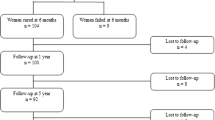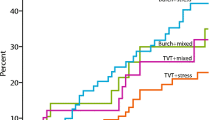Abstract
This study compared the incidence, duration, and predictors of early postoperative voiding dysfunction (VD) after three continence operations. Charts of women undergoing tension-free vaginal tape (TVT), Burch, or suburethral sling were reviewed. Early postoperative VD was defined as urinary retention or postvoid residual (PVR) >200 ml at discharge. Analysis of variance, Chi-square, and non-parametric tests were used. Sixty-three TVT, 42 Burch and 33 slings were identified. Incidence of VD with TVT, sling, and Burch was 50, 24, and 15%, respectively (P <0.001), and the mean number of days of postoperative catheter use was 9, 21, and 5 days, respectively (P=0.04). Patients with VD, compared with those with normal voiding, had smaller preoperative PVR (50 vs. 75 ml, P=0.005), longer catheterization (29 vs. 3 days, P<0.001), and more urinary tract infections (43 vs. 15%, P<0.001). Early postoperative VD is an underreported but frequent postoperative complication which is difficult to predict.
Similar content being viewed by others
References
Burch JC (1961) Urethrovaginal fixation to Cooper’s ligament for correction of stress incontinence, cystocele, and prolapse. Am J Obstet Gynecol 81:281–290
Burch JC (1968) Cooper’s ligament urethrovesical suspension for stress incontinence. Am J Obstet Gynecol 100:764–774
Alcalay M, Monga A, Stanton SL (1995) Burch colposuspension: a 10–20 year follow up. Br J Obstet Gynaecol 102:740–745
Amaye-Obu FA, Drutz HP (1999) Surgical management of recurrent stress urinary incontinence: a 12-year experience. Am J Obstet Gynecol 181:1296–1309
Langer R, Lipshitz Y, Halperin R, Pansky M, Sherman D (2001) Long-term (10–15 years) follow-up after Burch colposuspension for urinary stress incontinence. Int Urogynecol J 12:323–327
Goebel R (1910) Zur operativen beseitigung der angelborenen. Incontinentia Vesicae Z Gynakol Urol 2:187
Kohli N, Karram MM (1999) Surgery for genuine stress urinary incontinence: Vaginal procedures, injections, and the artificial urinary sphincter. In: Walters MD, Karram MM (eds) Urogynecology and reconstructive pelvic surgery. Mosby, St. Louis, pp 171–176
Morgan JE, Farrow GA, Stewart FE (1985) The Marlex sling operation for the treatment of recurrent stress urinary incontinence: a 16-year review. Am J Obstet Gynecol 151:224–226
Ulmsten U, Henriksson L, Johnson P, Varhos G (1996) An ambulatory surgical procedure under local anesthesia for treatment of female urinary incontinence. Int Urogynecol J 7:81–86
Nilsson CG, Kuuva N, Falconer C, Rezapour M, Ulmsten U (2001) Long-term results of the tension-free vaginal tape (TVT) procedure for surgical treatment of female stress urinary incontinence. Int Urogynecol J 12 [Suppl 2]: S5–S8
Rezapour M, Ulmsten U (2001) Tension-Free vaginal tape (TVT) in women with recurrent stress urinary incontinence—a long-term follow up. Int Urogynecol J 12 [Suppl 2]: S9–S11
Nygaard IE, Kreder KJ (1994) Complications of incontinence surgery. Int Urogynecol J 5:353–360
Kuuva N, Nilsson CG (2002) A nationwide analysis of complications associated with the tension-free vaginal tape (TVT) procedure. Acta Obstet Gynecol Scand 81:72–77
Dainer M, Cynthia DH, Choe J, Bhatia NN (1998) The Burch procedure: a comprehensive review. Obstet Gynecol Survey 239–250
Klutke C, Siegel S, Carlin B, Paszkiewicz E, Kirkemo A, Klutke J (2001) Urinary retention after tension-free vaginal tape procedure: incidence and treatment. Urology 58:697–701
Morgan JE (1970) A sling operation, using Marlex polypropylene mesh, for treatment of recurrent stress incontinence. Am J Obstet Gynecol 106:369–377
Al-Badr A, Ross S, Soroka D, Minassian VA, Karahalios A, Drutz HP (2003) Voiding patterns and urodynamics after Tension-free Vaginal Tape procedure. J Obstet Gynaecol Can 25:725–730
Kleeman S, Goldwasser S, Vassallo B, Karram M (2002) Predicting postoperative voiding efficiency after operation for incontinence and prolapse. Am J Obstet Gynecol 187:49–52
Abrams P, Cardozo L, Fall M, Griffiths D, Rosier P, Ulmsten U, van Kerrebroeck P, Victor A, Wein A (2002) The standardization of terminology of lower urinary tract function: report from the standardization sub-committee of the International Continence Society. Neurol and Urodyn 21:167–178
Theofrastous JP, Addison WA, Timmons MC (1996) Voiding function following prolapse surgery: impact of estrogen replacement. J Reprod Med 41:881–884
Bhatia NN, Bergman A (1986) Use of preoperative uroflowmetry and simultaneous urethrocystometry for predicting risk of prolonged postoperative bladder drainage. Urology 28:440–445
FitzGerald MP, Brubaker L (2001) The etiology of urinary retention after surgery for genuine stress incontinence. Neurourol Urodynam 20:13–21
Stanton SL, Cardozo LD (1979) Results of the colposuspension operation for incontinence and prolapse. Br J Obstet Gynecol 86:693–697
Kobak WH, Walters MD, Piedmonte MR (2001) Determinants of voiding after three types of incontinence surgery: a multivariable analysis. Obstet Gynecol 97:86–91
Author information
Authors and Affiliations
Corresponding author
Additional information
Presented as a poster presentation at the Society of Gynecologic Surgeons Annual Clinical Meeting in Anaheim, California, March 2003
Editorial Comment: The authors attempt to compare the incidence and predictors of early postoperative voiding dysfunction after TVT, Burch, and vaginal slings. Although not all preoperative characteristics were similar among the groups, no real definable characteristics or parameters were identified as risk factors for voiding dysfunction. The results would be strengthened by a randomized control trial of the three procedures
Rights and permissions
About this article
Cite this article
Minassian, V.A., Al-Badr, A., Drutz, H.P. et al. Tension-free vaginal tape, Burch, and slings: are there predictors for early postoperative voiding dysfunction?. Int Urogynecol J 15, 183–187 (2004). https://doi.org/10.1007/s00192-004-1134-z
Received:
Accepted:
Published:
Issue Date:
DOI: https://doi.org/10.1007/s00192-004-1134-z




